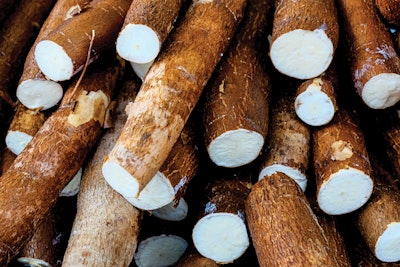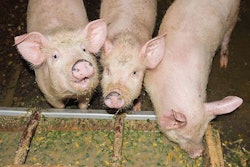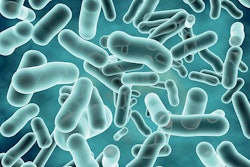
Yucca schidigera is a desert plant native to the United States and Mexico. Extracts and preparations of this plant appear to have several beneficial effects when included in the diets of animals and humans. While many studies exist on the effect of Y. schidigera, the exact mode of action for the various benefits is not well defined, and it is likely that numerous mechanisms are at work.
Additionally, the effects reported in the literature are conflicting and variable. Despite this, there appears to be merit in further investigating yucca as a feed additive.
Beneficial properties
Many desert plants can be rich in saponins, and Y. schidigera is no exception. The trunk of the plant can be used to produce dry, ground material (yucca powder) or the juice may be extracted via maceration then squeezing of the plant. This juice is then evaporated to produce a concentrated product known as yucca extract. The bark of the yucca plant is often removed during processing but is rich in stilbenes, which have antioxidant properties.
Saponins have been studied extensively in animal nutrition, and yucca is a good source. Steroidal saponins are able to bind ammonia and are surfactants and detergents due to fat- and water-soluble components; they make good foaming agents. As feed additives for ruminants, they have been shown to improve rumen nitrogen utilization, as well as reduce enteric methane production.
Yucca is used in livestock agriculture to reduce ammonia and control odor in housed and more extensive production systems.
While reducing ammonia and improving nitrogen use efficiency are key targets for dietary inclusion of yucca, the exact mode of action remains unclear and is likely a combination of mechanisms.
Saposins and rumen
Saponins are known to have antiprotozoal and antimicrobial activity. The mode of action of antibacterial effects of saponins seems to involve membranolytic properties, rather than simply altering the surface tension of the extracellular. Their antiprotozoal activity derives from the irreversible complexes that saponins form with sterols, such as cholesterol. As the latter are components of cell membranes in all organisms except prokaryotes (bacteria), saponins can disrupt cell membrane integrity and cause cell lysis and death. However, saponins are hydrolyzed by rumen bacteria and there is potential for the bacteria to adapt to yucca feeding leading to reduced efficacy of saponins over time.
Despite this, one study indicated no adaption by bacteria to dietary inclusion of yucca in vivo as protozoal numbers remained low throughout the 28-day experimental periods. That said, adaption may require longer than that time period so could still be an issue in practice. The ammonia-binding capacity is likely to have a very limited effect on reducing rumen ammonia levels given that binding ammonia at levels comparable to those found in the rumen is negligible.
The antiprotozoal effects may be involved in reducing rumen ammonia levels – protozoa ingest bacteria, resulting in proteolysis of bacterial protein and increases in rumen ammonia levels.

Yucca has been shown to reduce some greenhouse gas emissions in ruminants. | jantroyka, istock.com
Emission reductions
Numerous studies have shown reduced protozoal numbers and, as protozoa are implicated in a proportion of methane generation in the rumen and saponins are toxic to protozoa, the hypothesis is that yucca can reduce enteric methane production. An in vitro experiment found no effect of yucca on rumen fermentation parameters with the exception of methane. Addition of yucca reduced methane production over 24 hours with a variety of forage sources.
Effects on nitrogen metabolism may not be so clear cut. Reductions in serum urea and ammonia have been hypothesized to be as a result of an increase in the rate of urea clearance form kidneys. Work by the same authors demonstrated that some of the effects on nitrogen metabolism of yucca in vivo are unlikely to be due to the antiprotozoal and antimicrobial activity of the saponin-containing fraction. One study fractioned Y. schidigera into butanol and non-butanol fractions. The latter, containing carbohydrates and not saponins, reduced serum urea and ammonia concentrations, as well as reduced hindgut acetate:propionate ratio in rats.
Thus, they hypothesized that the antimicrobial activity of yucca is not a very probable explanation for effects in vivo.
A study using heifers showed increased propionate and reduced butyrate production and rumen ammonia concentration. Although not measured, it was hypothesized that methane production would also have been reduced. The effect of yucca on ruminal ammonia in this study likely results from decreased bacterial lysis (as a consequence of inhibited protozoal growth) and, to a lesser extent, from inhibited deaminative activity and direct binding of ammonia in the rumen. Dose-dependent reductions in methane and ammonia were also found with an in vitro continuous culture system.
Using ruminally cannulated Cheviot wethers, another study demonstrated reduced rumen ammonia and acetate, as well as increased propionate levels with dietary inclusion of yucca at 240 parts per million. Additionally, they noted an increased efficiency of microbial nitrogen synthesis (EMNS) via reduced urinary nitrogen and increased microbial nitrogen supply. They hypothesized that the higher EMNS value might be due to stable concentrations, and slow release of ammonia due the glyco-compounds of Y. schidigera, possibly resulting in enhanced microbial protein synthesis in the rumen.
Another possible reason for enhanced EMNS is inhibition of ciliate protozoa by saponins of Y. schidigera, thereby resulting in a higher number of bacteria participating in ruminal fermentation, increasing the amount of microbial biomass that passes to the small intestine.
Antibacterial effects
Yucca also has an antibacterial effect, and this appears greater on Gram-negative compared with Gram-positive bacteria. The effect is similar to that of ionophores but via different mechanisms. As yucca possess surfactant and detergent properties, there is potential to affect fat digestion, through emulsification (triacylglycerides) and micelle formation (free fatty acids). The main effect on fat digestion is via the formation of micelles with primary bile acids.
Despite this, another study saw no effect of dietary inclusion of yucca on ruminal fat digestion.
There is no definitive mode of action and effects are likely a combination of direct and indirect mechanisms. Variation in effects seen in the literature is probably explained by disparities between studies, including inclusion levels, fraction of yucca used, manufacturing process of the yucca source and adsorptive dilution of gut microflora.
References available upon request.
















